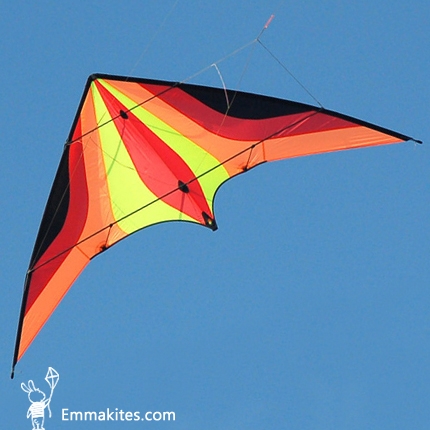Stunt kites are flown on fairly short lines, two of them. The lines are around 80-100 feet long. Most kites come with the correct length and wieght line for the kite you are flying.
The pilot must use the entire length of line supplied, especially if you are new to flying a stunt kite. The shorter the line, the faster the kite will respond to your commands. The smaller kites are fast enough without making them even faster with lines that are too short!
The pilot should stand with his/her back to the wind, with the kite directly in front. (It is helpful to have someone to launch the kite the first few times, we call this an assisted launch.) The pilot’s arms should be bent to 90 degrees, with elbows at the waist and hands directly in front of the belt buckle. The line in the right hand must be attached to the right side of the kite bridle, the line in the left hand must be attached to the left, as you look at the kite.
As the person assisting the pilot gives a very gentle launch skyward, the pilot pulls on each line equally so the hands end up at the waist or maybe a little behind the back. The kite will launch straight upward and stall at the top of the “wind window” awaiting your command. The pilot brings the hands to the ready position with the lower arms parallel to the ground and the hands in front of the belt buckle. Avoid the temptation to raise your hands over your head, it will not help and may make matters worse.
A solo launch is like an assisted launch, but the kite should start laying on it’s back, with the nose away from the pilot. gently pull on the lines equally so the kite rises on it’s wingtips. When you have the kite standing vertically and under control, give a quick pull on the lines to launch the kite.
With the kite stalled almost directly over your head, it is ready to receive your commands. Pull your right hand toward you about4-6 inches and the kite will rotate right. This is called a right pull circle. When the nose is pointed skyward, return your hand to the ready position and the kite will fly to the the top of the wind window and stall, awaiting your next command.
When you pull to the right, the kite rotates right. When you pull to the left, it rotates left. The most important thing for the pilot to know is that the kite will fly where the nose is pointed. If you leave it diving with the nose pointed to the ground, it will fly into the ground, HARD! This can damage the kite, as well as the pilot’s ego. If the nose is pointed straight up, it will fly straight to the top of the window and stall. If you get into “trouble”, fly up.
While the kite is rotating, the lines are getting wrapped around each other. When the lines feel sluggish, rotate right. If it gets worse, rotate left until the lines are not crossed.
The easiest way to land is to fly as far to the left or right as the kite will fly. You will notice that it stalls, because the sail is almost in line with the wind. You will be able to fly your kite onto it’s wingtip for a very gentle landing.
Practice a while and you will be able to form cirlces, eights, boxes, perform stalls and landings with the best stunt flyers around.
Keep the nose in the wind!

